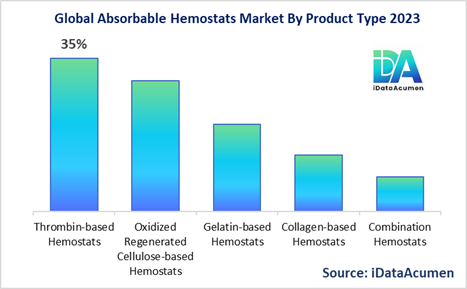The Global Absorbable Hemostats Market is expected to reach US$ 3.9 Bn in 2031, growing at a CAGR of 8.2% from 2024 to 2031. Absorbable hemostats are medical devices used to control bleeding during surgical procedures, falling under the broader medical devices industry. These hemostats are designed to be absorbed by the body over time, eliminating the need for removal after use, thereby improving patient comfort and reducing the risk of complications.
The market growth is primarily driven by the increasing prevalence of chronic diseases, such as cardiovascular disorders, cancer, and musculoskeletal conditions, which necessitate surgical interventions. Additionally, the growing adoption of minimally invasive surgical techniques and technological advancements in hemostatic products are fueling the demand for absorbable hemostats that are compatible with these advanced procedures and offer improved efficacy.
The Absorbable Hemostats Market is witnessing significant growth due to a confluence of factors, including rising healthcare expenditure, improving healthcare infrastructure, and the increasing adoption of advanced medical treatments. Market dynamics are shaped by the growing demand for effective hemostatic products that can enhance patient outcomes, reduce recovery times, and minimize the risk of complications. The market presents lucrative opportunities for manufacturers to develop innovative absorbable hemostats with faster absorption rates, improved biocompatibility, and integrated functionalities, such as antimicrobial properties or wound healing promoters.
The absorbable hemostats market falls under the medical devices industry. Absorbable hemostats are medical devices used to control bleeding during surgical procedures. They are designed to be absorbed by the body over time, eliminating the need for removal after use.
When a blood vessel is damaged or cut during surgery, it can lead to excessive bleeding, which can be life-threatening if not controlled promptly. Absorbable hemostats are applied to the bleeding site to promote clotting and stop the bleeding. They work by providing a matrix or surface that attracts and activates clotting factors, enabling the formation of a stable blood clot.

Key Report Insights:
- Increasing prevalence of chronic diseases and rising number of surgical procedures globally. According to the World Health Organization (WHO), the number of surgical procedures performed worldwide is projected to increase by 38% by 2030.
- Companies are focusing on developing advanced absorbable hemostats with improved efficacy, ease of use, and faster absorption rates. For example, Ethicon (a subsidiary of Johnson & Johnson) recently launched SURGICEL PREMIUM, an enhanced absorbable hemostat made from plant-based materials.
- Advancements in diagnostic techniques, such as advanced imaging modalities, have improved the early detection and diagnosis of conditions requiring surgical interventions, driving the demand for absorbable hemostats.
- The growing trend towards minimally invasive surgeries and the development of advanced surgical techniques are expected to fuel the demand for absorbable hemostats that are compatible with these procedures.
Drivers:
- The increasing prevalence of chronic diseases, such as cardiovascular disorders, cancer, and musculoskeletal conditions, is a major driver for the absorbable hemostats market. As the global population ages and lifestyle factors contribute to the development of these diseases, the demand for surgical interventions is rising, driving the need for effective hemostatic products.
- The growing trend towards minimally invasive surgical techniques, such as laparoscopic and robotic-assisted surgeries, has created a demand for hemostats that are compatible with these advanced procedures. Absorbable hemostats offer advantages in minimally invasive surgeries, as they can be easily applied through small incisions and provide effective bleeding control.
Trends:
- The development of plant-based absorbable hemostats is a notable trend in the market, as these products are derived from natural sources and offer advantages such as sustainability, lower risk of adverse reactions, and addressing ethical or religious concerns.
- Manufacturers are focusing on developing absorbable hemostats with faster absorption rates, as rapid absorption contributes to quicker wound healing and reduces the risk of complications.
Market Opportunity:
The integration of antimicrobial properties into absorbable hemostats represents a promising opportunity to address surgical site infections and improve patient outcomes.
Key Regional Insights:
- North America is expected to be the largest market for Absorbable Hemostats, accounting for over 35% of the market share in 2024. Prominent companies with a strong presence in the region include Ethicon (Johnson & Johnson), Baxter International Inc., and Pfizer Inc. The growth of the market in North America is attributed to the presence of major market players, well-established healthcare infrastructure, and the high adoption rate of advanced medical technologies.
- Europe is expected to be the second-largest market for Absorbable Hemostats, accounting for over 28% of the market share in 2024. Major companies operating in the region include B. Braun Melsungen AG, Gelita Medical GmbH, and Equimedical. The growth of the market in Europe is driven by the increasing prevalence of chronic diseases, aging population, and favorable reimbursement policies for surgical procedures.
- Prominent companies present in the Absorbable Hemostats Market include Ethicon (Johnson & Johnson), Baxter International Inc., Pfizer Inc., C. R. Bard, Inc. (Becton, Dickinson and Company), B. Braun Melsungen AG, Integra LifeSciences Holdings Corporation, Gelita Medical GmbH, Equimedical, and Biocer Entwicklungs GmbH.
Market Segmentation:
- By Product Type
- Thrombin-based Hemostats
- Oxidized Regenerated Cellulose-based Hemostats
- Gelatin-based Hemostats
- Collagen-based Hemostats
- Combination Hemostats
- By Application
- Cardiovascular Surgery
- General Surgery
- Orthopedic Surgery
- Neurosurgery
- Gynecological Surgery
- Plastic Surgery
- Others (Dental Surgery, Trauma Surgery)
- By End-User
- Hospitals
- Ambulatory Surgical Centers
- Clinics
- Others (Home Healthcare, Research Institutes)
- By Regions
- North America
- Europe
- Asia-Pacific
- Latin America
- Middle East & Africa
Definition:
“Absorbable hemostats are medical devices designed to control bleeding during surgical procedures. They provide a matrix or surface that attracts and activates clotting factors, enabling the formation of a stable blood clot and stopping the bleeding. These hemostats are made from materials that can be absorbed by the body over time, eliminating the need for removal after use. They are widely used in various surgical procedures, including cardiovascular, general, orthopedic, neurosurgery, and others, to ensure effective hemostasis and improve patient comfort and recovery times.”